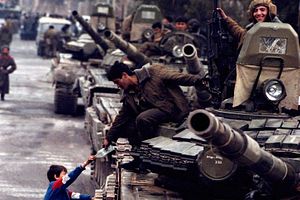Tajikistan is at peace; the civil war ended in 1997. President Emomali Rahmon’s supporters regularly boast of his unrivaled role in ending the conflict and bringing security and prosperity to Tajikistan, often assigning him sole credit. However, this peace has not resulted in a confident Tajik leadership. Whenever anybody advocates mobilizing for democratic change or the guarantee of human rights in Tajikistan, the Tajik government answers in the same way, arguing that reckless actions like protests, meetings, or the formation of new social movements or political parties would only create dangerous divisions and could even throw Tajikistan into a civil conflict just like Syria, for example (the country that serves as a warning changes occasionally, depending on what warzone is most prominent in the news).
The Tajik leadership and the state-controlled media are therefore always on message stressing how far Tajikistan has come out of the civil war and into a new era of stability and peace. At the center of this is always Rahmon, who has now expanded the title that state media and others must refer to him by: “The Founder of Peace and National Unity, Leader of the Nation, President of the Republic of Tajikistan, His Excellency Emomali Rahmon.”
But what sort of peace does Tajikistan have 20 years later? Critics stress that it is a peace where torture by security forces is the norm, where elections are neither free nor fair, where the president’s family is looting the country, and where the causes of the civil war – including a grossly unfair distribution of power – are more acute than ever. As for the population of Tajikistan, they are extremely pessimistic about their future inside Tajikistan, but also increasingly apolitical. The vast majority of the population is concerned only about their meager economic survival week-to-week, all the while navigating a heavily corrupt economy and government that are dominated by the president’s family and his inner circle.
The utter social and economic defeat of the Tajik people is on regular display, the most recent example being the lines of citizens waiting outside failing banks trying to determine if their deposits have been entirely lost or not. On their way to the bank they may see on display the billions of dollars wasted on the president’s vanity projects – monuments and glittering, but empty, buildings, as well as billboards hailing the multi-decade project that is the Rogun hydroelectric dam boondoggle. These billions of dollars, diverted to regime insiders and contractors, could have been used to strengthen or bail out the banking sector after the collapse in remittances from Tajik labor migrants in Russia. But as usual, the funds ended up in the pockets of the president’s patronage network. If any Tajiks complain, the retort from Rahmon’s supporters usually includes the time-proven scare tactic: remember what happened the last time Tajiks came into the streets and protested? The civil war.

































